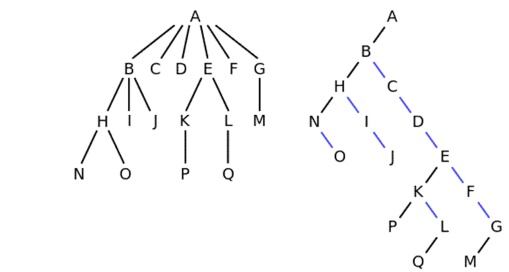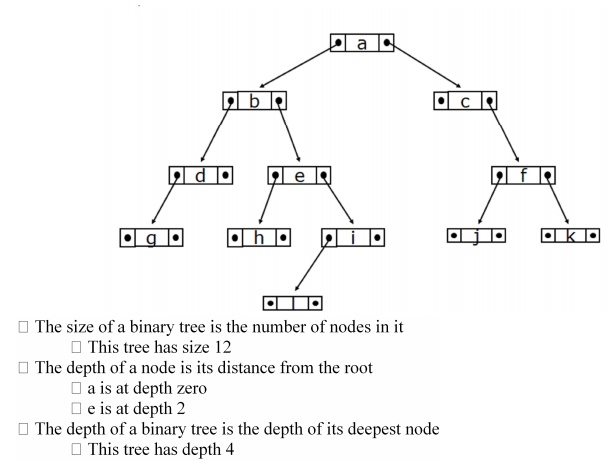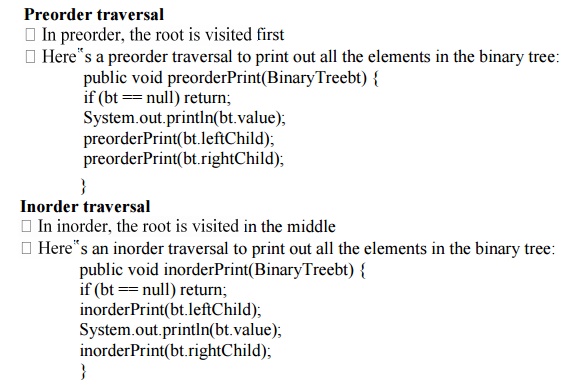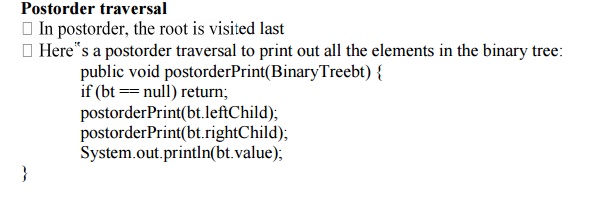Chapter: Object Oriented Programming and Data Structure : Non-Linear Data Structures
Common operations of binary trees
Common operations
There are
a variety of different operations that can be performed on binary trees. Some
are mutator operations, while others simply return useful information about the
tree.
Insertion
Nodes can
be inserted into binary trees in between two other nodes or added after a leaf
node. In binary trees, a node that is inserted is specified as to which child
it is.
External nodes
Say that
the external node being added onto is node A. To add a new node after node A, A
assigns the new node as one of its children and the new node assigns node A as
its parent.

Internal nodes
The
process of inserting a node into a binary tree Insertion on internal nodes is
slightly more complex than on external nodes. Say that the internal node is
node A and that node B is the child of A. (If the insertion is to insert a
right child, then B is the right child of A, and similarly with a left child
insertion.) A assigns its child to the new node and the new node assigns its
parent to A. Then the new node assigns its child to B and B assigns its parent
as the new node.
Deletion
Deletion
is the process whereby a node is removed from the tree. Only certain nodes in a
binary tree can be removed unambiguously,
Node with zero or one children

The
process of deleting an internal node in a binary tree Say that the node to
delete is node A. If a node has no children (external node), deletion is
accomplished by setting the child of A's parent to null. If it has one child,
set the parent of A's child to A's parent and set the child of A's parent to
A's child.
Node with two children
In a
binary tree, a node with two children cannot be deleted unambiguously.[7]
However, in certain binary trees (including binary search trees) these nodes
can be deleted, though with a rearrangement of the tree structure.
Traversal
Pre-order,
in-order, and post-order traversal visit each node in a tree by recursively
visiting each node in the left and right subtrees of the root.
Depth-first order
In
depth-first order, we always attempt to visit the node farthest from the root
node that we can, but with the caveat that it must be a child of a node we have
already visited. Unlike a depth-first search on graphs, there is no need to
remember all the nodes we have visited, because a tree cannot contain cycles.
Pre-order is a special case of this. See depth-first search for more
information.
Breadth-first order
Contrasting
with depth-first order is breadth-first order, which always attempts to visit
the node closest to the root that it has not already visited. See breadth-first
search for more information. Also called a level-order traversal. In a complete
binary tree, a node's breadth-index (i - (2d - 1)) can be used as traversal
instructions from the root. Reading bitwise from left to right, starting at bit
d - 1, where d is the node's distance from the root (d = floor(log2(i+1))) and
the node in question is not the root itself (d > 0). When the breadth-index
is masked at bit d - 1, the bit values 0 and 1 mean to step either left or
right, respectively. The process continues by successively checking the next
bit to the right until there are no more. The rightmost bit indicates the final
traversal from the desired node's parent to the node itself. There is a
time-space trade-off between iterating a complete binary tree this way versus
each node having pointer/s to its sibling/s.
Encoding general trees as binary trees
There is
a one-to-one mapping between general ordered trees and binary trees, which in
particular is used by Lisp to represent general ordered trees as binary trees.
To convert a general ordered tree to binary tree, we only need to represent the
general tree in left child right sibling way. The result of this representation
will be automatically binary tree, if viewed from a different perspective. Each
node N in the ordered tree corresponds to a node N' in the binary tree; the
left child of N' is the node corresponding to the first child of N, and the
right child of N' is the node corresponding to N 's next sibling --- that is,
the next node in order among the children of the parent of N. This binary tree
representation of a general order tree is sometimes also referred to as a left
child-right sibling binary tree (LCRS tree), or a doubly chained tree, or a
Filial-Heir chain. One way of thinking about this is that each node's children
are in a linked list, chained together with their right fields, and the node
only has a pointer to the beginning or head of his list, through its left
field. For example, in the tree on the left, A has the 6 children
{B,C,D,E,F,G}. It can be converted into the binary tree on the right.

The
binary tree can be thought of as the original tree tilted sideways, with the
black left edges representing first child and the blue right edges representing
next sibling. The leaves of the tree on the left would be written in Lisp as:
(((N O) I
J) C D ((P) (Q)) F (M))
which
would be implemented in memory as the binary tree on the right, without any
letters on those nodes that have a left child.
Binary Trees
A binary
tree is composed of zero or more nodes


Preorder traversal


Related Topics